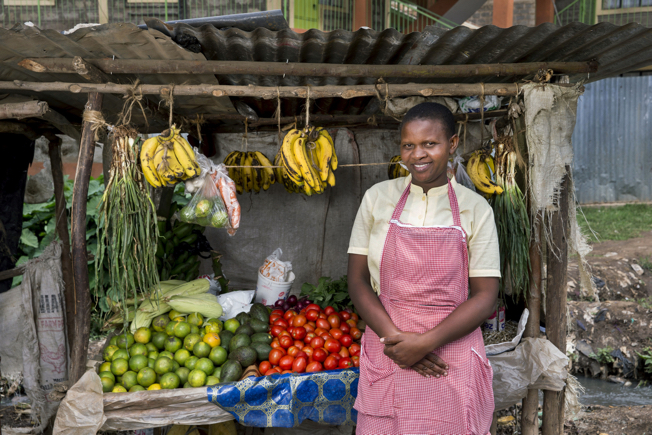One of the members of the Nairobi Young and Old cooperative group in front of her fruit and vegetable stand in a local market in Nairobi. This income generating activity enables her to have some financial independence and not rely on her husband, when spending money on health and education for her children. (Photo Credit: Jonathan Torgoknik/ Getty Images, licensed under CC BY NC 4.0)
“What does ‘women’s economic empowerment’ mean?” As a member of the team that works on it at the Hewlett Foundation, that’s a question I’ve been asked many times. When we started to work on the issue back in 2012, my answer was long and technical. I talked a lot about data gaps and nuances of policy, and I often watched the eyes of genuinely interested people glaze over. Since then, I’ve honed it down to something like this:
“Economic policies, laws, and regulations affect women and men differently and those differences have consequences for the well-being of everyone—especially children. Leaders and citizens need to understand these inequities and the economic impact they have on the real lives of men and women. Only with this understanding can people make smart decisions that empower both women and men to live self-determined lives and reach their fullest potential.”
Uh oh, did I just hear you snoring? Okay. Maybe it’ll help if I give you an example from one of the projects we support, the International Finance Corporation’s recently published report Women, Business and the Law 2016. This report is a survey of 173 developing and developed economies that measures legal restrictions on women’s employment and entrepreneurship. It’s a go-to source for examples of how reformed economic and legal decisions can affect families and entire nations.
“Giving women greater access to assets through inheritance can change outcomes for children, particularly girls. In 1994, two states in India, Karnataka and Maharashtra, reformed the Hindu Succession Act to allow women and men the same rights to inherit joint family property. This altered control over assets within families and increased parental investments in daughters. The second-generation effects were even larger in such areas as daughters’ education. For example, mothers who benefitted from the reform spent twice as much on their daughters’ education. Moreover, where the reforms occurred, women were more likely to have bank accounts and their households were more likely to have sanitary latrines, suggesting that legal empowerment gives women more bargaining power within the household and leads to better educational and financial outcomes for families. Although the reform was initiated at the state level, it has now been implemented throughout India.”
Did you catch that? A change in gender-biased inheritance laws led to more girls going to school, and better living conditions for families.
Now maybe your eyes are a little less glazed over, and you can see what women’s economic empowerment looks like. Examples like this are why I come to work every day, and they’re part of our vision of a more just world.
That’s a world where a mother has the bargaining power to invest in better lives for everyone in her family—herself included. It’s a world where all women have the choice to become whatever they want. (Of the 173 economies surveyed by Women, Business, and the Law, 100 restrict non-pregnant and non-nursing women from pursuing the same economic activities as men.). It is one built on the premise of equal pay for women doing the same job as men. (According to the UN Foundation, women in most countries earn on average only 60 to 75% of men’s wages.). And it’s one where laws protect a wife from abuse from her husband. (Of the 173 economies surveyed in Women, Business and the Law, 46 have no laws specifically protecting women from domestic violence.). This better world will mean that a woman can travel outside her home without her husband’s permission. (In the 173 economies surveyed, 17 have laws prohibiting wives to travel outside the home.). In short, it’s a world where laws and economic policies support the economic, physical, and mental well-being of everyone—every man, woman, and child, equally.
Clearly, that’s not the world we live in. Which brings me back to why I wrote this post. There’s a lot of jargon around women’s economic empowerment, and a lot of vital work gets obscured by it. If you’re still with me, I hope your eyes are less glazed over. Because getting to that vision of a better world will require all of our efforts.



